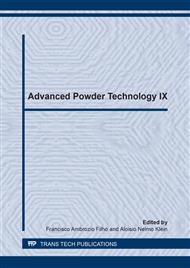p.3
p.9
p.14
p.20
p.25
p.29
p.35
p.41
p.46
Effect of Mechanical Alloying on Characteristic of Powders of Amnoia Hepatamolybdate, Copper and MoCu Sintered
Abstract:
The mechanical alloying of Mo-Cu powders allows the production of highly homogeneous sintered pieces, with very thin Mo particles and good dispersion of Mo particles in the ductile Cu phase, allowing the development of a route for the preparation of Mo-Cu simple composite powders, environmentally sustainable and able to increase the sinterability of the material without causing damage to their properties of thermal conductivity and electrical. Was used the precursor powders of molybdenum (Ammonium heptamolybdate) plus Cu, where two samples were prepared by mixing processes. For mechanical alloying, and by mixing manually, and both reduced and sintered in a resistive furnace with hydrogen gas. The materials were analyzed by optical microscopy, XRD and density measurements. The results confirm the effect of mechanical alloying on the increasing in high density of the sintered samples and thereby producing superior properties to those shown by the mixing manually sample.
Info:
Periodical:
Pages:
25-28
Citation:
Online since:
December 2014
Keywords:
Price:
Сopyright:
© 2014 Trans Tech Publications Ltd. All Rights Reserved
Share:
Citation:


